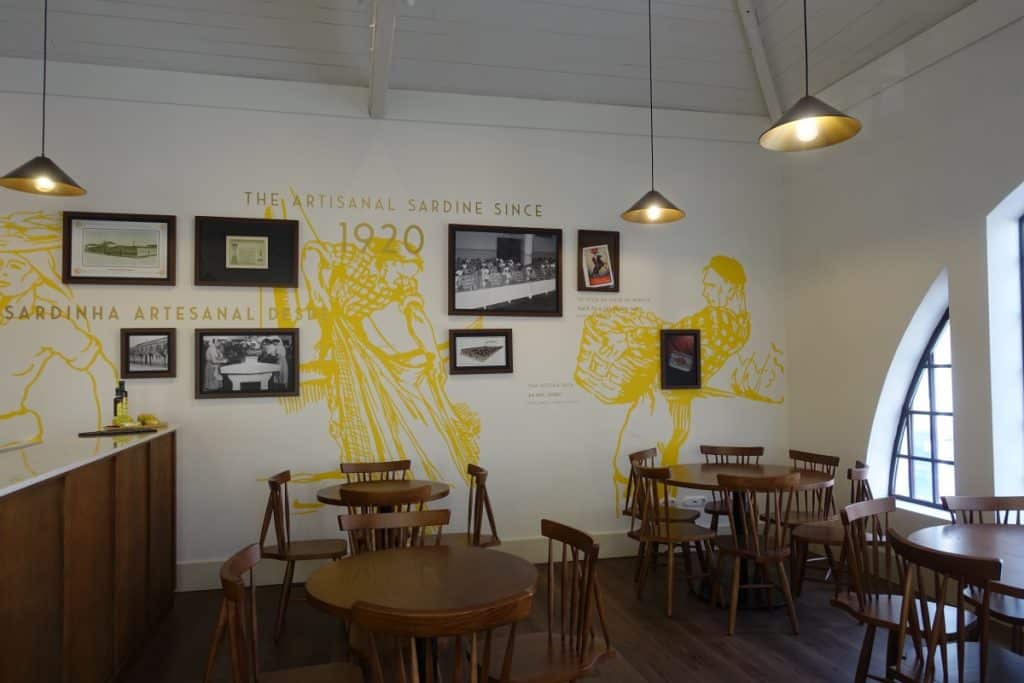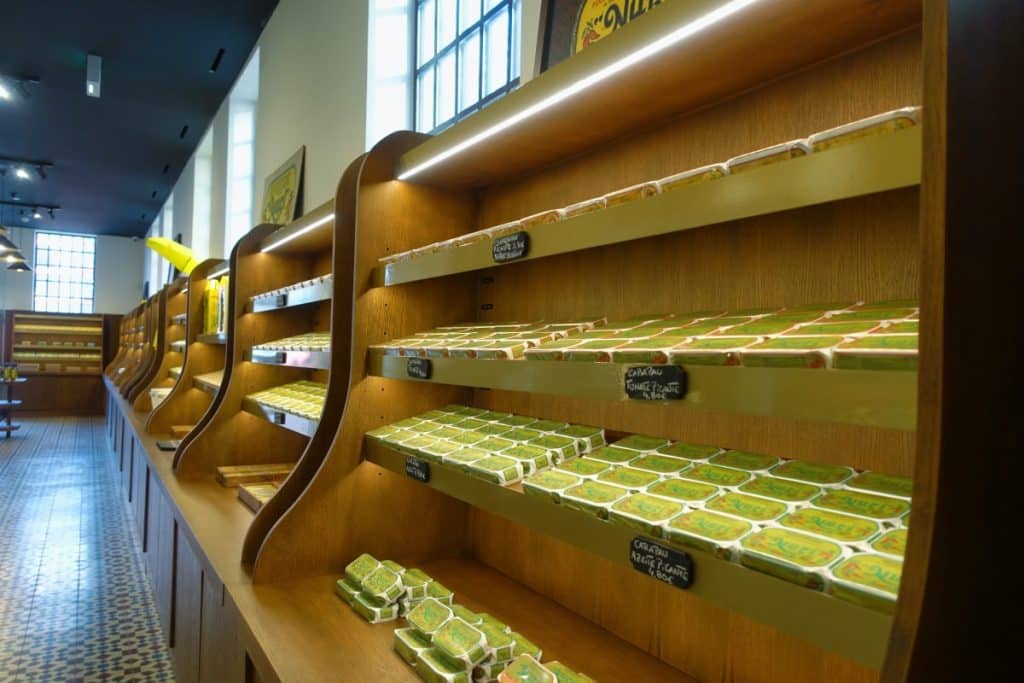If you are out and about in Porto, you will come across shops that only sell sardines in tins and even in the supermarkets there is a huge range of fish in tins. During our visit to the Pinhais cannery, we investigated the question – how does the fish get into the can?
Admittedly, when I made the appointment for the guided tour of the Pinhais cannery, I was a little sceptical. What could you possibly see there – the processing is surely done by machine. How wrong I was, I could not know at that time.

The sardine
The Atlantic or European sardine is an edible fish. The fish is mainly found in the waters of the north-eastern Atlantic, the North Sea, the Mediterranean, the Maramar Sea and the Black Sea. There it is mainly caught with purse seines and drift nets.
The sardine has an almost cylindrical body and can grow to about 27.5 centimetres. The meat has a fat content of 5.2 per cent.
Grilling is popular in Portugal and Spain. The somewhat smaller fish are often canned.

How the fish got into the can…
Well-known methods of preserving fish are salting, smoking or drying.
In 1804, the Frenchman Nicolas Appert founded the world’s first canning factory. It was not until 1812 that the Englishman Peter Durand received a patent describing the use of tins as preserving vessels. From 1880 onwards, the then large deposits of sardines off the coasts of Portugal began to be fished in a more targeted manner and preserved in the sardine canning factories. In 1908, there were 29 factories producing fish tins in the Algarve alone.
The oil sardine is preserved in vegetable oil. The preserve has quite a long shelf life and the fish has a high nutritional value. The tin can has a very distinctive shape. The tin is small, cuboid-shaped with rounded corners and it is opened with a pull ring.

Canning Pinhais – canned sardines and mackerel
The cannery is not located directly at the sea, but in the middle of Matosinhos. Until a few years ago, there were still about 50 sardine factories with about 6000 employees in the town just a few kilometres from Porto. A good 200 boats went up to the sea every day and their catch was processed in the factories. Today, there are only about 20 boats that go out to catch sardines and the number of factories in the city has also dropped drastically.

The family business Pinhas was founded in 1920 and is one of the oldest canning factories in Portugal. About 160 employees work here.

Our tour begins as we step through the old entrance to the company. Time seems to have stood still here. The tiles on the floor, the tiles on the walls and even the stairs in the entrance hall are still in their original state. And already here you notice what the family is passionate about. Even the staircase, if you look closely, replicates the shape of a fish.

After taking a look at the former treatment room of the company doctor, we went into an office. Not so long ago, the office staff sat here. Time seems to have stood still here as well. The old company safe, office furniture, telephones and the “order lift” showed us how work used to be done here. I found the “order lift” particularly exciting. If an order came in by phone, you hung a piece of paper on a belt and turned it until the paper arrived in production. The order could then be processed there.


Visit to the production
But of course, during the tour of the Pinhais cannery, you can not only learn about the company’s philosophy and history, you can also find out all about the sardine in the can.
After we had been suitably equipped, we went straight into production.

And here I discovered that the fish is still canned by hand at Pinhais. Honestly, I had not expected that. From a small platform, it was possible to observe the ongoing operation of the factory.
At the Pinhais cannery, the processing of the fish begins at the marble washing tables. The fish are sorted, deboned, the intestines removed, the head washed off and placed individually in a grid in a basket. All the production staff work here. It has to be quick so that the goods stay fresh.

The filled wire baskets are then placed in an oven and heated. Afterwards, the sardines cool down.
Only when all the fish has been processed do the women change their workplace. Now they prepare by hand the 6 ingredients that can be found in every fish tin with oil from the company. For example, carrots are peeled, sliced and then placed in the can. Only then does the fish go into the tin. To do this, cut off the fins and tail and always put three fish in the tin.

The next processing step is the only step where machines are used in this company. The olive oil is poured in and the can is closed and cleaned by machine.
Packing fish tins in paper
Then the cans are first stacked on pallets. What follows at the Pinhais cannery took me completely by surprise. Every single can is wrapped by hand in paper (some also in paper and foil) and taped shut. This work is also done by the female employees who are responsible for processing the fish. Only when all the fish delivered is in the can does it go to the packing station for them. We were first briefly shown how to pack the cans and then we were allowed to try it out ourselves.
Of course we photographed our work. Well, which can is ours? At the end of the tour, we could buy our packed can and take it home with us.

The ready-packed fish cans can then go on sale. There are a total of 37 steps before the fish can be eaten.
After experiencing this working process, I can understand the price that is charged for the canned products of this brand. The only question was – do the sardines taste good?
Fish tasting in the company café
The tour ended in the café. Here, even if you have not taken part in a guided tour, you can taste the products, have lunch or just a drink.

The fish tasting was already waiting for us. We had previously opted for the “spicy” version. But there is also the possibility to choose a “normal” version. There were two opened cans and some bread on the table. One tin contained sardines in olive oil, the other tin mackerel in tomato sauce.

The fish was simply delicious. I had in mind my last supermarket can I bought, where the fish fell apart just by looking at it. Here, the spicy fish was firm and could be lifted out of the tin in one piece.
The oil and also the tomato sauce were very well seasoned, not a drop was left in the can. In terms of taste, both offerings met our taste. The price-performance ratio is more than justified.
Finally, we browsed through the shop and of course bought a can or two.

Pinhais or NURI – which can do you use?
NURI is the better-known brand of the Pinhais cannery. The cans are sold all over the world. The second brand of the company is called Pinhais. It is of higher quality (also has the nicer tins) and the tins are correspondingly more expensive. Which fish from which can tastes better? Just try it out…

Address:
Avenida Menéres 700,
4450-189 Matosinhos,
Portugal
Admission prices:
Adults: 15,-€
Discounts are offered.
Dates:
Guided tours are regularly offered in English, Portuguese, French and Spanish. Guided tours in German are offered irregularly or on request. You should check the dates for the tours online and also book directly on the webseite of the provider.
Thank you for the German tour.


Leave a Reply